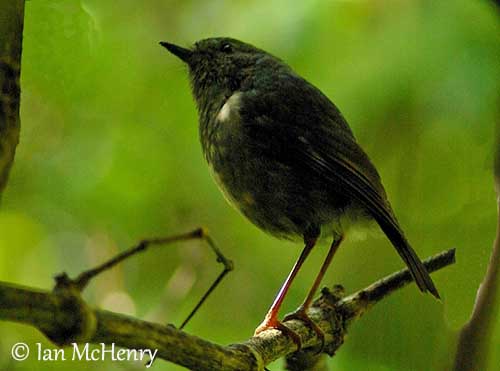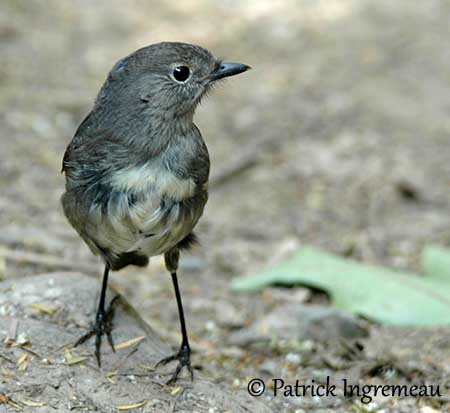
Fr: Miro rubisole
Ang: New Zealand Robin
P.a. australis: South Island Robin
P.a. longipes: North Island Robin
P.a. rakiura: South Island Robin (Stewart Island)
All: Langbeinschnäpper
Esp: Tordo de Nueva Zelandia
Ita: Balia bruna neozelandese
Nd: Nieuw Zeeland-vliegenvanger
Sd: Nya Zeelandsydhake
Maori: Toutouwai
Photographers:
Ken Havard
My Bird Gallery & Flickr gallery 1 & Flickr gallery 2
Patrick Ingremeau
TAMANDUA
Ian McHenry
My New Zealand Birds
Simon Tan
PBase Bird galleries
Text by Nicole Bouglouan
Sources:
HANDBOOK OF THE BIRDS OF THE WORLD Vol 12 by Josep del Hoyo-Andrew Elliott-David Christie - Lynx Edicions - ISBN: 8496553423
KNOW YOUR NEW ZEALAND BIRDS by Lynnette Moon - New Holland Publishers – ISBN: 1869660897
BirdLife International (BirdLife International)
New Zealand bird status between 2008 and 2012
New Zealand birds and birding (Narena Olliver)
Wikipedia, the free encyclopaedia
Te Ara – The Encyclopedia of New Zealand
New Zealand Robin
Petroica australis
Passeriformes Order – Petroicidae Family
INTRODUCTION:
The New Zealand Robin is endemic to New Zealand. According to the authors, this species has three recognized subspecies (australis, longipes and rakiura), but the race “longipes” from North island is often considered a full species after recent molecular tests. The local Maori’s name is “toutouwai”.
DESCRIPTION OF THE BIRD:
Biometrics:
Length: 18 cm
Weight: 33-47 g
The three subspecies look very similar. The adult male of nominate race “australis” has dark grey head, neck and upperparts, including wings and tail.
On the underparts, chin, throat and breast feathers are paler grey with fine pale streaking. Lower breast, belly, vent and undertail-coverts are white, but also creamy-white or yellowish-white. Sides of breast and belly, and flanks are dark grey, whereas the thighs are washed brownish.
The bill is blackish, and we can see a small, white dot on the forehead above the bill. The eyes are dark brown. The long, thick legs are blackish, and well adapted to the terrestrial behaviour of the bird. The feet are blackish above, and the soles are yellow.

Both sexes are almost similar, with slightly paler upperparts, throat and flanks in female.
The juvenile resembles female but it has slightly browner plumage.
SUBSPECIES AND RANGE:
P.a. longipes occurs in northern New Zealand including North Island, Little Barrier and Kapiti islands.
This one has grey head, upperparts and breast streaked whitish and less-extensive white on the underparts. The female is often paler than male.
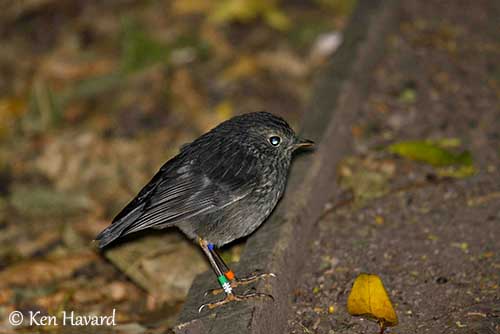
P.a. australis (here described but not displayed) is found in South island, S New Zealand.
P.a. rakiura occurs on Stewart Island, off S South Island. This race has more extensive white on the underparts.
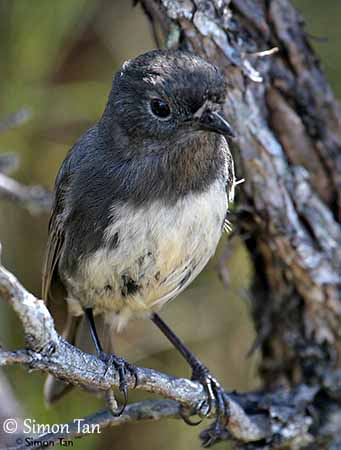
HABITAT:
The New Zealand Robin frequents the dense, mature native forests and some exotic plantations with thick leaf litter on the ground. It is often found in manuka (Leptospermum) and kanuka (Kunzea) scrubs. It can frequent more open areas if there is sufficient vegetal cover. This species can be seen from sea-level to tree-line.
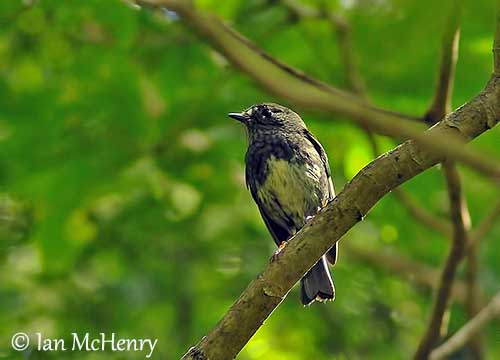
CALLS AND SONGS: SOUNDS BY XENO-CANTO
The New Zealand Robin male usually sings from high perches. The song is a series of loud warbles, rising and falling in pitch “tink tink tink tink tink tonk tonk tonk tonk tonk tonk”. The series starts with rather plaintive notes followed by full, ringing sounds. The song can last up to 20 minutes or more without pause.
The advertising call is a descending series of loud notes. The contact call is a “chuck”. A more aggressive call includes 3-20 loud “chuck” notes starting fast and slowing towards the end.
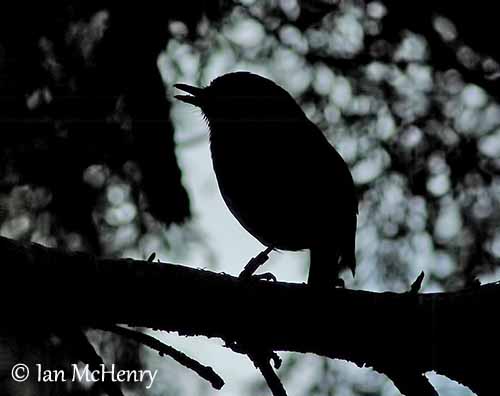
BEHAVIOUR:
The New Zealand Robin feeds on insects, worms and grubs. Insects include a wide variety of species such as Cicadidae, caterpillars, large moths, weta (orthoptera) and stick-insects (Phasmida). It also takes spiders, earthworms and grubs, and occasionally berries.
It spends much time on the ground or within two metres above it, foraging for food by hopping rather than walking, while plucking preys under the leaf litter. The larger preys are dismembered and bashed on hard surface.

The New Zealand Robin often caches food items in various sites such as stumps, moss, holes or crevices, and retrieves them within 24/48 hours. During summer, it moves to higher level and hunts in the upper storey of forests. On small islands, it feeds mainly on the ground.
The New Zealand Robin is monogamous and the pairs have long-term pair-bonds. They are territorial throughout the year, and especially during the breeding season.
The Petroicidae perform wing-flicking during displays, and courtship feeding of female by the male is fairly common.
The male does not take part in nest building and incubation, but it feeds the female during these periods, and the chicks are fed by both adults.
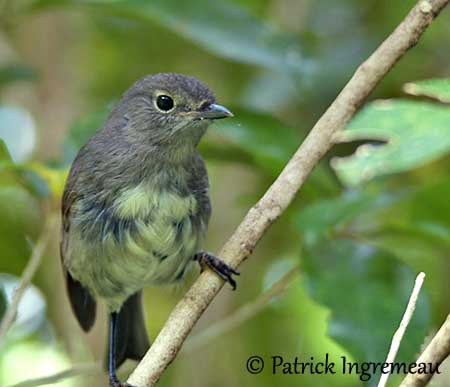
This species is sedentary in its range. However, the young birds usually disperse after the breeding season.
The flight is fast and direct through the forest.
REPRODUCTION OF THIS SPECIES:
The breeding season occurs from September to January. This species can produce more than three clutches per season.
The female alone builds the nest during about one week. The nest is a bulky cup made with twigs, moss and rootlets. Nest materials are bound with spider’s web. The inner cup is lined with tree-fern scales and other soft items such as moss and fine grass. It is placed in tree fork, hollow in tree or in shallow crevice in old tree, also in vines or epiphytes.
The New Zealand Robin nests at lower level than Tomtit, up to 10 metres, but usually between 3,5 and 5,5 metres above the ground.
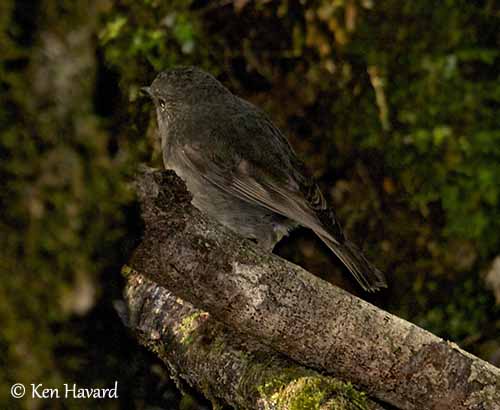
The female lays 2-4 eggs and incubates during 17-22 days. She broods the chicks but both parents feed them. They fledge about 19-22 days after hatching.
If a predator approaches and threatens the chicks, both sexes perform distraction display on the ground (often injury-feigning), to lead the predator away from the nest. They may also perch above the head of the intruder.
Other displays are used to distract the intruder from the nest. Both parents fly close by, and with fanned wings and tail, spiral to the ground where they slowly move from side to side.
After fledging, the young are still fed during 3-7 weeks and the brood is divided between the parents. Later, the male continues to feed them alone while the female lays another clutch 1-2 weeks after the young fledge.
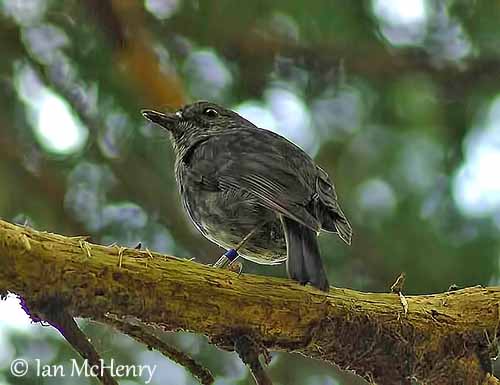
PROTECTION / THREATS / STATUS:
The New Zealand Robin is vulnerable to predation by stoats and cats while feeding on the ground, and the nests are attacked by rats. Forest and land clearance involve declines in populations.
The race “longipes” has stable populations and is not threatened.
The race “rakiura” has restricted range but the population is slightly recovering with 1,000/5,000 mature individuals.
The race “australis” is not threatened and its population is stable.
Currently, the New Zealand Robin is not threatened and evaluated as Least Concern.
